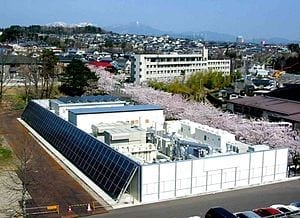
Four solar homes built by students at Missouri University of Science and Technology will soon become home to an experimental microgrid to manage and store renewable energy.
The houses, all past entries into the Solar Decathlon design competition, make up the university’s Solar Village.
In its initial phase, the project involves Missouri S&T students and researchers, along with representatives from utility companies, the Army Corps of Engineers and several Missouri businesses. The goal is to demonstrate the feasibility of small-scale microgrids for future use.
“Distributed power generation is one of the key elements of a microgrid. In our case, we’re using solar panels,” says Dr. Mehdi Ferdowsi, associate professor of electrical and computer engineering at Missouri S&T. “It’s called a microgrid because it’s less dependent on the utility power grid. The idea is that if there is a blackout, it can operate in what we call ‘islanded mode,’ and convert to using stored solar energy.
“Utility companies are interested to see if this could be a viable business model for the future,” he says. “For example, they could rent out renewable energy generators to subdivisions, creating a new paradigm for selling electricity.”
Ferdowsi says that Missouri S&T’s Solar Village is an ideal place to test microgrid technology. “The four houses were built in a 10-year span of time and each was designed individually, but converting them to the technology is not complicated,” he says.
Students living in the solar houses will monitor the results. “We hope to demonstrate that the technology is expandable to many, based on these four houses,” he says. “The students will also demonstrate the human aspect of the project — how people interact with a new system of energy management.”
Components necessary for the project include batteries for energy storage, a power electronic converter, software and hardware.
Two lithium battery racks were donated by A123 Systems Inc. (now Wanxiang Group) in December. Ferdowsi estimates their combined worth at $75,000 to $100,000. “These batteries are very efficient, but they are super heavy with 8-foot-tall racks,” he says. “We hope to have them installed in a shed in the Solar Village by the end of summer, along with the converter.” The hardware and software would be located in the houses.
Photovoltaic (PV) arrays on the solar homes are designed to generate about 25 kilowatts of power. The donated batteries will provide 60 kilowatt hours of energy storage for the microgrid.
Researchers are now deciding which converter and intelligence system to purchase. “Security is also a factor — we want to be sure the system is hacker-proof,” says Ferdowsi.
Several Missouri S&T alumni serve on the advisory council that was created to guide the integration of microgrid components into the Solar Village, and to ensure the microgrid is designed for future expansions.
The Latest Bing News on:
Microgrid
- WattEV continues to make charging infrastructure a non-issue along the West Coaston May 8, 2024 at 6:32 am
The heavy-duty charging depot developer opens its fourth heavy-duty charging station within a year, serving Southern California via microgrid with solar energy. The company ...
- Egyptian utility launches tender for 8.2 MW solar-plus-storage projecton May 8, 2024 at 1:09 am
State-owned utility Egyptian Electricity Holding Company is requesting expressions of interest for the design, building and operation of a 8.2 MW solar plant and 2 MW/4MWh battery energy storage ...
- Great Quotations in Charm City: Notable Quotes from Microgrid Knowledge 2024 Conference in Baltimoreon May 7, 2024 at 11:42 am
So we thought we would display a few of the most quoted quotes from Microgrid Knowledge 2024. For those who came we were thrilled to have you there. For those who couldn’t, ...
- Toyota announces two new renewable energy steps in Californiaon May 7, 2024 at 3:30 am
Toyota Motor North America has announced two major renewable energy steps it is taking in California. Toyota’s R&D office in Los Angeles County will be renamed the North America ...
- TIGON project: pioneering microgrids to bridge legacy AC grids and DC outputon May 6, 2024 at 9:01 am
Science X is a network of high quality websites with most complete and comprehensive daily coverage of the full sweep of science, technology, and medicine news ...
- Philippines Microgrid As A Service (MaaS) Market Size Expected to Fly High with Increased Demandon May 2, 2024 at 9:57 pm
Report Ocean recently released a research report on the Philippines Microgrid As A Service (MaaS) Market, which covers the market’s historical growth, cost structure, revenue, trends, and potential ...
- Philippines Microgrid Controller Market Big Profits on the Horizon as Market Size Continues to Growon May 1, 2024 at 4:39 am
Report Ocean recently released a research report on the Philippines Microgrid Controller Market, which covers the market’s historical growth, cost structure, revenue, trends, and potential prospects ...
- Eaton Among Groups Supporting Microgrid Buildout in Puerto Ricoon May 1, 2024 at 3:05 am
Companies operating in Puerto Rico have paid particular attention to the reliability and resiliency of their power supply after a series of major hurricanes battered the island in recent years. Those ...
- Hydrogen Fuel Cell Microgrid Project: Energy Innovation, Integration and Assuranceon April 30, 2024 at 1:23 pm
BWR Innovation announces it was recently granted a two-year subcontract by The Global Connective Center, LLC as a part of an agreement with the Air Force Research Laboratory (AFRL) to develop and ...
- Fully electric Oregon elementary school aims for resilience with microgrid designon April 29, 2024 at 5:00 pm
The roughly 78,000-sf school in a Portland suburb will feature a microgrid—a small-scale power grid that can operate independently from the area’s electric grid. Design of the microgrid system was ...
The Latest Google Headlines on:
Microgrid
[google_news title=”” keyword=”microgrid” num_posts=”10″ blurb_length=”0″ show_thumb=”left”] [/vc_column_text]The Latest Bing News on:
Distributed power generation
- Adani Dahanu Thermal Power Station facilitates Industrial Visits for Engineering Studentson May 9, 2024 at 3:26 am
Senior plant officials guide the students through every step, from coal intake to power transmission and distribution to the end consumers ... students gain a deeper understanding of power generation ...
- London allocates $25 million to help repair Ukraine’s power gridon May 8, 2024 at 4:41 pm
The funds, which are expected to be made available shortly, will be allocated for purchasing equipment to restore damaged energy infrastructure, as well as for enhancing physical protection and ...
- Mexico hit by hours of rolling blackouts after high temps, low power generationon May 8, 2024 at 9:37 am
Mexico has been hit by hours of rolling blackouts late Tuesday due to high temperatures and temporary drops in electrical power generation ...
- Mexico hit by hours of rolling blackouts due to high temperatures and low power generationon May 8, 2024 at 8:36 am
Mexico has been hit by hours of rolling blackouts late Tuesday due to high temperatures and temporary drops in electrical power generation.
- Solar Tops 50% of New U.S. Power Generation for the First Time in 2023; Southern Company Subsidiaries Help Lead the Wayon May 8, 2024 at 8:32 am
In the Southeast, Southern Company and its subsidiaries are leading the way in this solar expansion. As we work across the company to enable a net-zero transition, our renewables portfolio continues ...
- ‘We have the software to cope with rapid changes’: Tigo Energy on the distributed energy data delugeon May 7, 2024 at 5:00 pm
One company that has sought to capitalise on the proliferation of data being generated from distributed energy resources is Tigo Energy, whose ‘Predict+’ uses AI and machine learning to forecast power ...
- Xcel’s grid, facing growing power demands, to get help from a bill racing through the legislatureon May 1, 2024 at 7:52 am
Legislation would help the utility boost investment in its power grid to meet growth in rooftop solar, EVs and building electrification ...
- Decarbonizing the Power Industry with Low-Carbon-Intensity Hydrogenon April 30, 2024 at 5:00 pm
Steam Boilers. Steam boilers are another important application of the power and steam generation sector, these highly efficient pieces of equipment are perhaps one of the best early use cases for ...
- Edge Computing May Be the Future of Power Distributionon April 30, 2024 at 5:00 pm
Today, however, the dynamics of distribution are evolving rapidly, as power generation simultaneously changes. Predictable patterns of generation are shifting to embrace new, more varied solutions, ...
- Global power and distribution transformers’ market value likely to reach $23.60bn and $27.73bn in 2028on April 30, 2024 at 8:09 am
Leading data and analytics company GlobalData’s latest report, Transformers Market Size, Share and Trends Analysis by Technology, Installed Capacity, Generation, Key Players and Forecast to 2028, ...
The Latest Google Headlines on:
Distributed power generation
[google_news title=”” keyword=”distributed power generation” num_posts=”10″ blurb_length=”0″ show_thumb=”left”]










